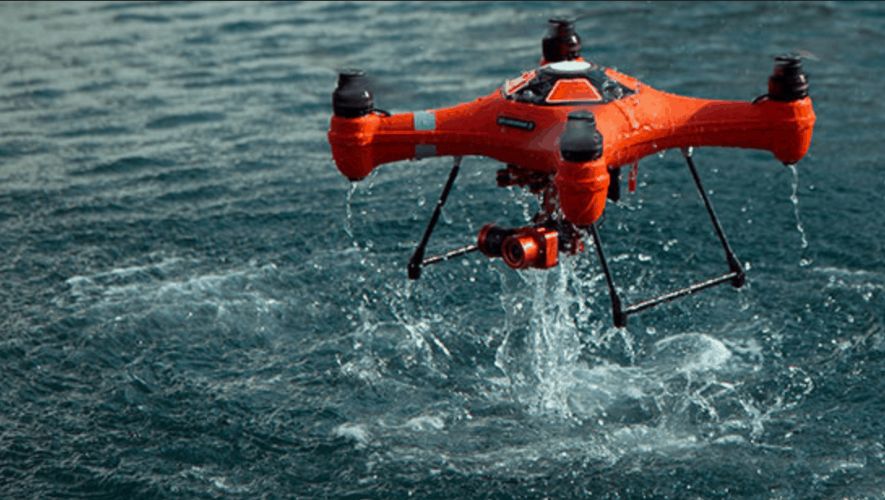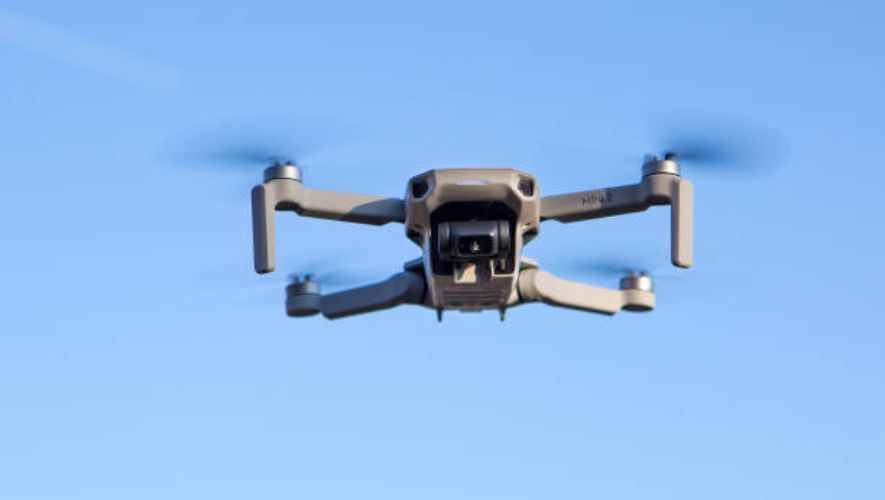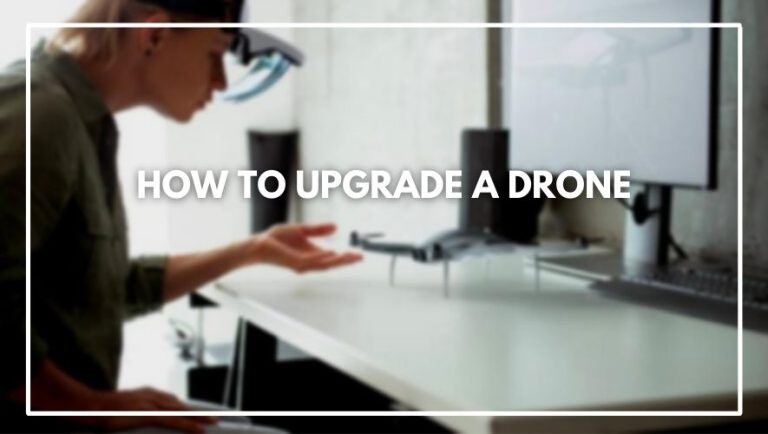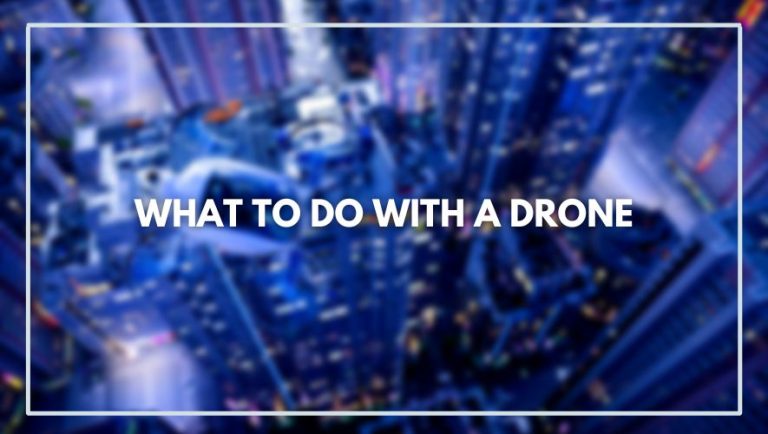It’s the middle of winter and you’ve been itching to fly your drone. You just need to wait for a sunny day, right? Wrong. It doesn’t have to be sunny for you to fly your drone outside! In fact, some people think that flying in rain can actually be better than flying in the sun due to the reduced wind and increased visibility.
Yes, you can fly your DJI drone in the rain. But make sure you have an adequate cover for your drone. It should be waterproof and protect all components, especially its camera ! Always keep an eye on your battery level before entering inclement weather. Check local regulations regarding drone use.
That said, you do need to consider some things before you take off during a downpour: what type of drone are you flying? Is it waterproof? How much water damage will it sustain if there’s an accident? And most importantly: Can I fly my DJI drone in the rain? We’ll explore these questions below so that we can all enjoy our drones no matter what kind of weather conditions occur on our adventures!
What Should You Consider Before Flying In The Rain?

Before flying your drone in the rain, it is important to consider the following:
- Check the weather forecast. The best time to fly a drone is early morning or late afternoon (before sunset).
- Check the weather radar. If there’s lightning, don’t fly! It can be dangerous for both you and your drone. Remember that drones are very sensitive electronic devices and should not be used during thunderstorms or heavy rain because they could get struck by lightning and damaged beyond repair.
- Check wind speed, direction, and air pressure.
- Be aware of temperature changes as well as humidity levels—if it’s too hot outside your battery might overheat! Also keep an eye on cloud cover; if there isn’t much visibility around then maybe it’s best not go flying at all.
Internal Moisture
It’s important to avoid getting water inside the drone. If your drone gets wet and you don’t take action, it could be ruined.
To prevent water from getting inside your drone, make sure that the propellers are clean and free of dirt or other contaminants before flying. Check them periodically while flying too—one little bit of dirt can get under one of the propellers and cause damage! This will help keep out any dust or moisture that may sneak in through gaps between parts of the aircraft.
If you do find yourself with a wet drone after flying in rainy conditions (or even just when it rains), try to dry it off as soon as possible by placing in a warm room away from heat sources like lights or radiators for several hours.
If that doesn’t work, use a hairdryer on low heat with no air flow directed at any part of your product until completely dry; use more caution if using hot air because high temperatures may damage some components such as circuit boards or plastics used on components like motors/propellers so always test first before proceeding further!
If this still does not work then take advantage of our 1-year warranty service plan – we’ll repair/replace damaged items quickly so you can get back up into the skies again soon enough!
When To Fly Your Drone In The Rain
You can fly in the rain, but with some caveats. You should only do this if you are confident that there will be no lightning and if the rain is not too heavy. If it’s raining hard enough that your drone will get wet, don’t fly it. The same goes for strong winds—if it’s windy enough to make flying unsafe, then don’t risk it.
The conditions need to be right before you take off as well: You’ll want a calm day when there’s chance of rain (and not just a passing shower) so that your battery won’t drain quickly during flight.
Also keep in mind how cold or hot the temperature is outside; while many batteries can handle being exposed to water at higher temperatures without any damage, they may suffer damage if they’re exposed to freezing ones.
What To Do If Your Drone Gets Wet?

Do Not Fly Your Drone If It Has Been Wet
You should not fly your drone until you are sure it is dry, and that includes being exposed to the wind. Even if an indoor flight is okay, this can damage the components of your drone, especially if it’s a high-end model.
Don’t Use A Drone That Is Washing Machine Cleaned
According to Dji, “If you have been using your Mavic 2 Pro in harsh weather conditions or have accidentally dropped it into water frequently then we strongly recommend cleaning out all of the dirt with some compressed air before continuing to use it.” If you do need to wash your Mavic 2 Pro quadcopter only use a hand towel and ensure that no water gets inside any part of the drone as this may cause harm when flying again later on down the road.
Can You Fly A Dji Drone In The Rain?
No, DJI drones are not waterproof and should not be flown in heavy rain or snow. While it’s possible to fly your DJI drone in light rain, it’s not recommended.
If you do choose to fly in light rain, keep an eye on the weather forecast and only go out when there is no thunderstorm activity within 30 miles of your location.
If your drone gets wet, make sure that you dry it off as soon as possible. Even if it looks like water has drained from its body or from its camera lens protector (the “visor”), let it sit for at least 24 hours before turning on again so that all moisture can evaporate from inside the aircraft’s electronic systems and wiring harnesses.
Which Dji Drones Are Waterproof?

Spark, Phantom 3/4, Mavic Air 2, Mavic Pro and Matrice 200. The Agras drones are waterproof but not the other DJI drones.
Dji Mini/mini 2
The Dji Mini/mini 2 is not waterproof. You can fly it in rain, but you have to be careful. If it starts raining while the drone is in flight, the camera will get wet and stop working (you’ll see red on your screen). It’s best to land immediately and wait for the weather to pass before continuing with your flight.
To keep yourself safe from getting wet or accidentally dropping your drone into water, invest in a drone carrying case that has built-in rain protection. The Parrot AeroPod Waterproof Carrying Case is one great option—it completely covers the drone so that no water can get inside of it. This case also comes with its own carabiner clip so you can attach it to a backpack or belt loop while traveling!
Dji Spark
The Dji Spark is a great drone for beginners and experts alike. It’s small, so it’s easy to fly in tight spaces (like indoors) and has simple controls that make it easy for anyone to learn how to fly a drone. The Spark also comes with an intelligent flight system that will keep you from crashing into things or flying too high up the first time you take it out.
There are plenty of reasons why this would be your best choice as a beginner, but there are also plenty of reasons why experts should consider buying one as well:
Dji Phantom3/phantom 4
The DJI Phantom 3 and Phantom 4 are both waterproof. There is no need to take them apart before flying in the rain, but you should clean them out after each flight. If there’s too much water inside your quadcopter, it could cause damage to the electronic components.
You should always keep an eye on your battery life while flying in the rain or snow as well. You may lose power faster than normal due to low temperatures or foggy conditions that affect visibility.
Dji Mavic Air 2
With the Mavic Air 2, you can fly your drone in inclement weather with less worry of damage. The Mavic Air 2 is waterproof up to a depth of 1 meter (3.3 feet), which means no matter what Mother Nature throws at your drone, it should be safe from harm. Don’t forget to protect its sensors by covering them when you’re not flying!
Dji Mavic Pro
You may be wondering, “Can I fly my drone in the rain?” The answer is yes! But there are a few things to consider before you do.
First and foremost, there is moisture inside your Dji Mavic Pro that can damage it. Moisture will destroy electronic components—so it’s important to make sure your drone doesn’t get wet when flying in rain or snow. One way to do this is by using waterproofing spray on the circuit board and battery compartment of your Mavic Pro before each flight.
A second consideration is whether or not the weather conditions have changed since you last checked them; if they have, then let someone else know about them so they can decide whether or not they should go ahead with their plans for today (or another day).
Finally, if your drone does get wet during flight: DO NOT turn off any of its motors! Doing so could damage them beyond repair due to static electricity buildup from having been exposed to water vapor while flying outside.
Dji Matrice 200
The Dji Matrice 200 is a drone designed for professional use. It is waterproof and dustproof, which allows you to fly your drone in bad weather conditions.
The Matrice 200 can be used in temperatures between -4°F and 104°F. Even if it gets a little wet, don’t worry! The drone will still work just fine after you land it safely on the ground or in water.
Dji Agras
DJI’s newest drone, the Agras, is waterproof. This means that you can fly it in the rain and not worry about damage to your drone or camera.
However, keep in mind that just because a drone is waterproof doesn’t mean it’s water resistant. If you’re flying your Agras outside and get caught in a heavy downpour, don’t try to use it while being pelted by raindrops (we’ve been there). The electronics inside the drone can get wet and cause permanent damage if they’re exposed to moisture for too long.
How To Waterproof Your Drone
You can waterproof your drone in a few different ways, but the most common are:
- using a ziplock bag or another type of waterproof bag to keep your drone and accessories dry.
- using an actual waterproof case. These come in hard shells and soft cases. They’re great for keeping both the controller and drone dry, but may be slightly bulky for some people when flying in large bodies of water.
- getting a drone that is already waterproofed like the Parrot AR 2.0 or Dji Spark (or saving up for one). This way you don’t need to worry about taking precautions with individual components or accessories like batteries or propellers since they’ve been designed specifically with water safety in mind as part of their manufacturing process
How To Get Water Out Of Your Drone

How to get water out of your drone
- Use a dry cloth. This is the most basic way of drying your drone, and it’s also the least effective (unless you have an amazing cloth that absorbs water at lightning speed).
- Dry it with a hair dryer. Not all drones can withstand high heat, so be sure to check the manufacturer’s instructions before using any kind of heat tool on your machine. If you do decide to use a hair dryer, be careful not to let too much time pass between when you turn off the device and when you fly again; otherwise, condensation will form on your camera lens or other parts inside that could damage them permanently.
- Use a vacuum cleaner to remove excess moisture from any openings in which water may have entered during flight or landing—for example, if there was rain above where you landed but none below where you parked yourself.
- Get creative with kitchen appliances! A rice cooker can help remove excess moisture from inside components of both small and large drones alike; simply place them inside along with some uncooked rice for two hours without turning it on (be sure not put any actual food items into whatever container has been selected).
- If this method fails because there is too much moisture trapped inside—or if after following these steps there’s still not enough space available for storage—try using heat guns instead: as long as they aren’t too hot (which would melt plastic components), these tools should help reduce condensation build-up while increasing roominess by removing nonessential equipment like cameras or gimbals so they don’t take up valuable space inside
Frequently Asked Question (can I Fly My Dji Drone In The Rain)
What Do I Do If My Drone Crashes?
If you have crashed your drone, you must report the incident to the police if you were flying in an area that is public (e.g., on a sidewalk) or to your insurance company if it was private property.
In addition, it’s recommended that you also report the incident to the Civil Aviation Authority (CAA), who will need details of where and when this happened so they can investigate what went wrong.
What Are The Requirements To Fly A Drone In The Uk?
As a drone pilot, you must be 16 or over to fly in the UK. You also need permission to fly your drone in this country and must follow the rules that make up the national drone regulations. These rules are in place for several reasons; they help protect people and property from harm, as well as help keep aircraft flying safely.
Your age is not an issue if you’re taking part in training for a job in which operating drones could be involved, such as an air traffic controller or police officer using one for search-and-rescue missions.
What Should I Do If I Have Had A Collision Whilst Flying My Drone?
If you’ve had a collision, you should contact the CAA as soon as possible. You will need to give them your details. They will also want to know where the drone is and what happened. If you have any footage of the collision, make sure that this is sent to them too.
Are There Any Places That I Am Not Allowed To Fly My Drone In The Uk?
You are not allowed to fly your drone near an airport or military base. You should also avoid flying your drone near prisons, power stations or any other areas that could be dangerous for people and property if you lose control of it.
For example, if a prison is on fire due to arson or rioting and you fly your drone over the prison while there is still fighting inside the grounds, this would be very dangerous for both inmates and officers. If a nuclear power station catches fire then even one small explosion could cause a chain reaction leading to disaster for whole surrounding areas nearby.
You must also make sure that no one else can see what you’re filming with their own eyes because of privacy issues surrounding personal information like names/addresses etc…
How Can I Make Sure That I Am Flying My Drone Safely In The Uk?
In order to fly your drone safely and legally, you must do the following:
- Take a drone piloting course.
- Read the user manual that comes with your DJI product.
- Follow the rules of the air (you can find these on transport.gov.uk). In particular, avoid flying near airports or in restricted airspace unless you have permission from the relevant authority – meaning that if there’s an airport nearby it’s unlikely that you’ll be able to fly there at all so make sure this isn’t something you want to do before buying a drone!
- Fly within your capabilities as a pilot: don’t try anything new if it makes you nervous; always keep an eye on how steady your hands are holding up against potential winds; ensure that if something starts going wrong then there is enough time for recovery actions before getting into real trouble such as getting hit by another aircraft!
Are Drones Allowed At Football Matches And Other Large Events?
Most large events like sports or concerts are generally fine to fly your drone at, as long as you have permission from the organiser. You must also follow all of the other rules on flying your drone safely and responsibly.
You should not fly within 50 metres of an event where people are present, unless it is approved by the organiser. You should not fly over crowds of people or high buildings such as stadiums and arenas because this can cause accidents or injuries to them if there were to be a problem with your drone while flying it.
How Close Am I Allowed To Fly A Drone Near An Airport In The Uk?
In the old days, you had to fly your drone no closer than 50 metres from any airport.
Nowadays, this has been reduced to 150 metres. If you’re flying within 150 metres of an airport you can contact them and get permission to fly as long as it’s not interfering with their operations or disrupting flights.
Conclusion
Yes, you can fly your DJI drone in the rain. However, there are some precautions you should take to ensure that it stays safe, secure throughout this process and must check drone’s battery level to make sure it’s fully charged.
You will have to decide if you want your drone to be waterproof, but it will be worth it in the end. The DJI drones are great and they have many features that make them even better.
It is also important for you to know when not to fly your drone in the rain so that you don’t damage it or hurt yourself while doing so.






